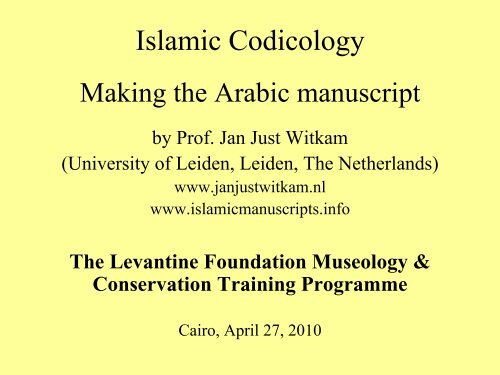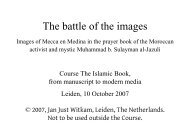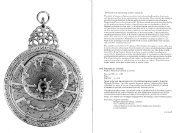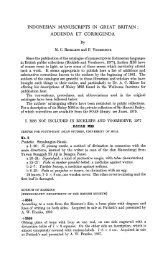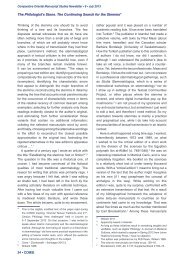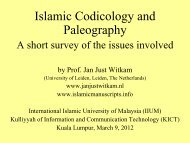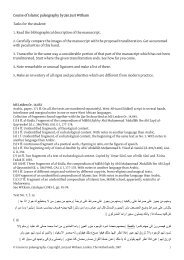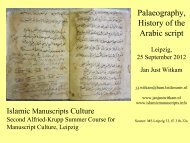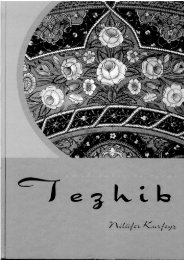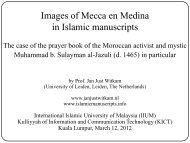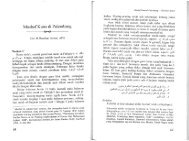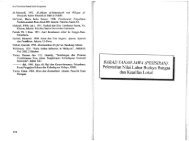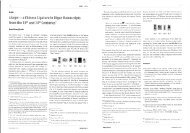Dia 1 - Islamic manuscripts
Dia 1 - Islamic manuscripts
Dia 1 - Islamic manuscripts
Create successful ePaper yourself
Turn your PDF publications into a flip-book with our unique Google optimized e-Paper software.
<strong>Islamic</strong> Codicology<br />
Making the Arabic manuscript<br />
by Prof. Jan Just Witkam<br />
(University of Leiden, Leiden, The Netherlands)<br />
www.janjustwitkam.nl<br />
www.islamic<strong>manuscripts</strong>.info<br />
The Levantine Foundation Museology &<br />
Conservation Training Programme<br />
Cairo, April 27, 2010
Summary: Division of codicological subjects:<br />
- writing surface: papyrus, parchment, paper, other<br />
- quires: organization of the codex<br />
- instruments<br />
- techniques: ruling, lay-out<br />
- craftsmen<br />
- scripts: paleography, styles, calligraphy<br />
- ornamentation: illumination, illustration<br />
- bookbinding<br />
- dating a manuscript<br />
- collections of <strong>manuscripts</strong><br />
- terminology in use<br />
(Summary of subjects, following F. Déroche 2006)
The making of the manuscript, instruments<br />
A number of instruments and techniques are necessary to produce a<br />
manuscript.<br />
First there are the pens necessary to write with. In the <strong>Islamic</strong> and<br />
Middle-Eastern realm these have almost exclusively been reed pens.<br />
Then there are inks, to be made according to certain recipes. These<br />
inks are kept ready in ink-wells.<br />
Coloured inks are used, and sometimes colouring is used for the<br />
paper (we will not treat this in detail).<br />
These instruments are used by the copyist after he has made up his<br />
mind concerning the lay-out of the book.<br />
Lay-out instruments will be shown and discussed. Lay-out in the<br />
<strong>manuscripts</strong> will be discussed in the follow-up.
Varieties of reed pens<br />
from the Maghrib and<br />
from the Mashriq.<br />
Source: F. Déroche 2006, p. 105
A glass inkwell of<br />
Roman times, and detail.<br />
Source: not noted. Original in Leiden<br />
Museum of Antiquities.
A ceramic inkwell from Morocco (19th/20th century) for<br />
the making of polychrome <strong>manuscripts</strong>.<br />
Source: Original in collection J.J. Witkam, Leiden.
Another ceramic inkwell from Morocco (19th/20th century)<br />
for the making of polychrome <strong>manuscripts</strong>.<br />
Source: Original in collection J.J. Witkam, Leiden.
Another ceramic inkwell from Morocco (19th/20th century)<br />
for the making of polychrome <strong>manuscripts</strong>.<br />
Source: Original in collection J.J. Witkam, Leiden.
Another ceramic inkwell, with silver frame, and<br />
provided with a Maghribi reed pen, from Morocco<br />
(19th/20th century) for the making of polychrome<br />
<strong>manuscripts</strong>. Source: Original in collection J.J. Witkam, Leiden.
The same ceramic inkwell, with silver frame, and provided<br />
with a Maghribi reed pen, set in its holder, from Morocco<br />
(19th/20th century), for the making of polychrome<br />
<strong>manuscripts</strong>.<br />
Source: Original in collection J.J. Witkam, Leiden.
Inkwells from Central-Asia for making monochrome <strong>manuscripts</strong>.<br />
Source: Originals in collection J.J. Witkam, Leiden.
Inkwell from Central-Asia for making monochrome <strong>manuscripts</strong>, with pen rest.<br />
Source: Originals in collection J.J. Witkam, Leiden.
Inkwells for making <strong>manuscripts</strong> in two colours.<br />
Source: Originals in collection J.J. Witkam, Leiden.
Portable penholder with inkwell, for making <strong>manuscripts</strong> in two<br />
colours. Ottoman style after originally Japanese design.<br />
Source: Originals in collection J.J. Witkam, Leiden.
Reed and bambu pens.<br />
Source: Originals in collection J.J. Witkam, Leiden.
Reed pens, Middle-East.<br />
Source: Originals in collection J.J. Witkam, Leiden.
The Reed pen and its parts<br />
Source: Adolf Grohmann, Arabische Paläographie I (1967), p. 120
Mistara, ruler with fixed lay-out, and line-applier of bone<br />
(from Egypt) Source: Originals in collection J.J. Witkam, Leiden.
(يا فتاح) Paper scissors (Egypt), with detail: Ya Fattah<br />
Source: Originals in collection J.J. Witkam, Leiden.
Bibliographical references:<br />
François Déroche, <strong>Islamic</strong> Codicology. An Introduction to the study of Manuscripts in<br />
Arabic Script. London 2006<br />
Adolf Grohmann, Arabische Paläographie. Vol. 1. Graz, etc. 1967<br />
References to <strong>manuscripts</strong> in the Leiden library can be found in the on-line inventories<br />
by J.J. Witkam. These can be accessed through the URL: www.islamic<strong>manuscripts</strong>.info<br />
and then navigate => inventories => Leiden.


